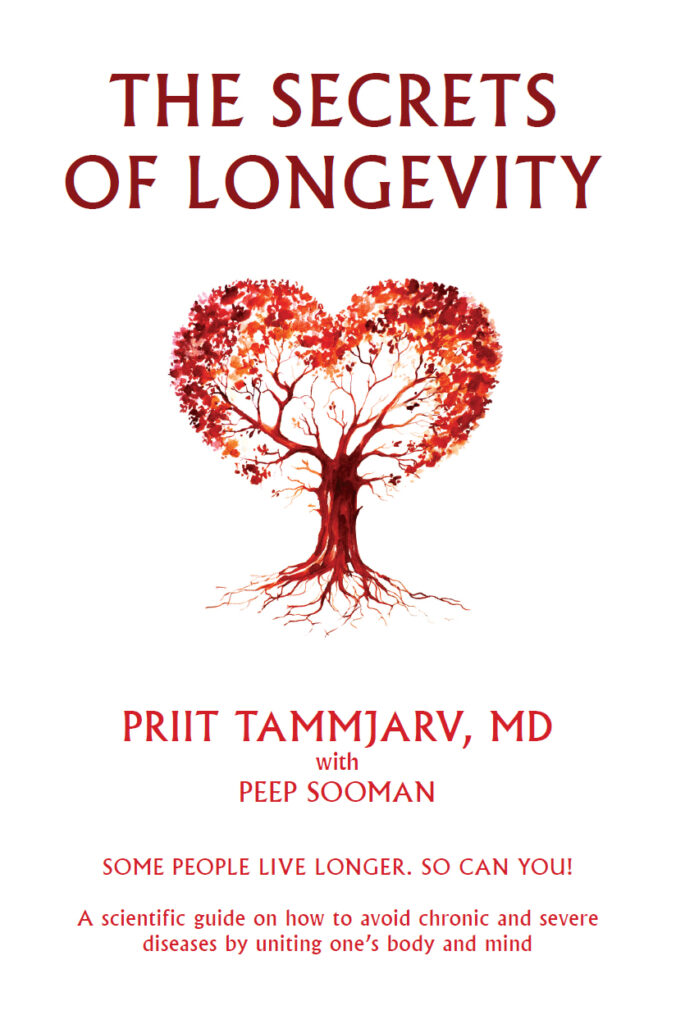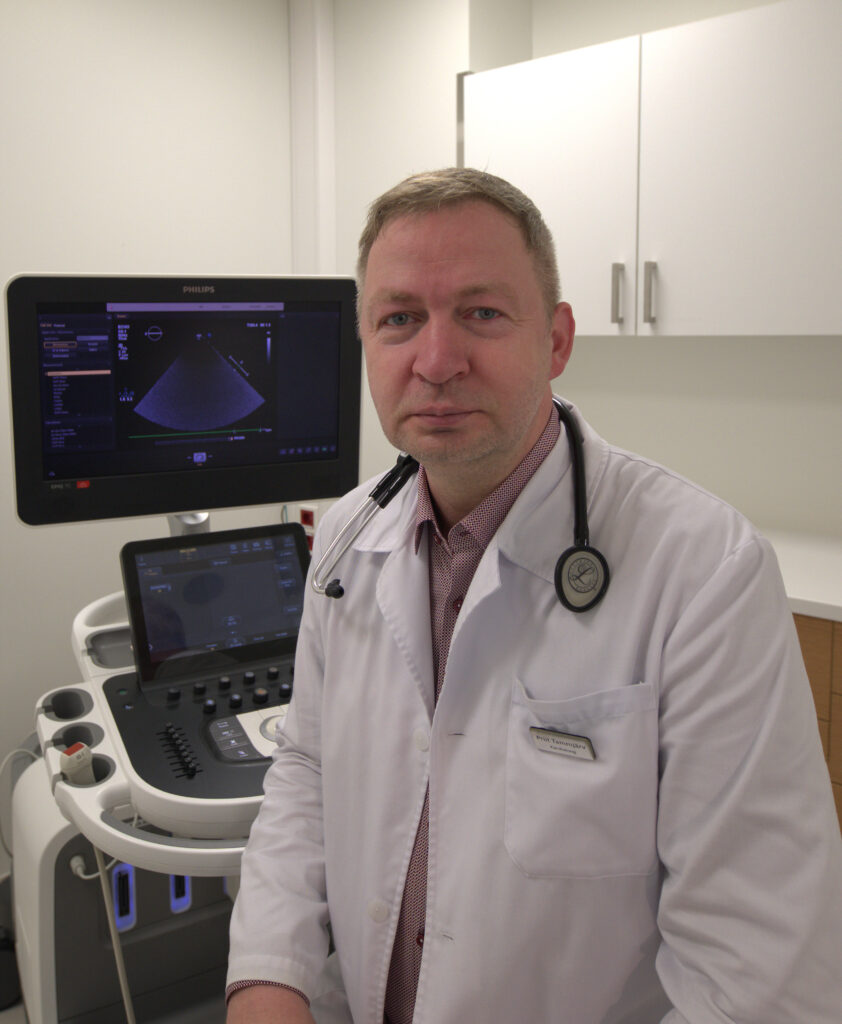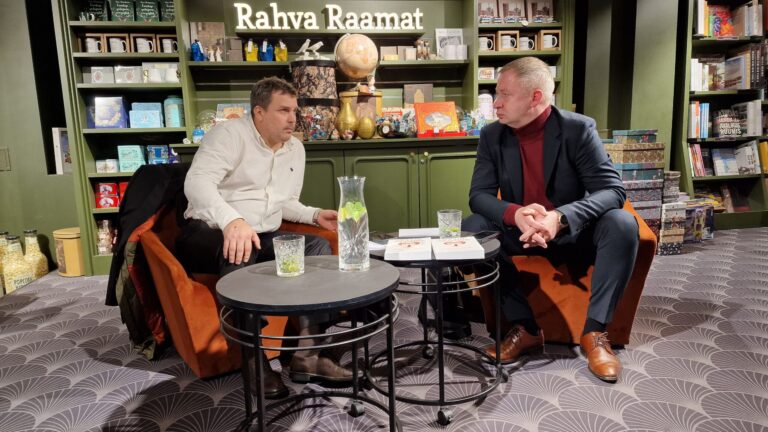Two Estonians – cardiologist Priit Tammjärv, and author and property entrepreneur Peep Sooman – have published a health and lifestyle book about the most common lifestyle diseases and a definitive guide on how to avoid them, and therefore live a long, healthy and a happy life; the book was first published in Estonian and now is also available in English.
“The Secrets of Longevity” is a unique book in its genre. As the authors themselves say, there are a million similar books, but at the same time, there are also none.
“It is a very simply written book that describes lifestyle diseases, their causes and also different techniques to improve your wellbeing and health in general,” Peep Sooman says. “The biggest problem with the rest of the million such books is that either the terminology is too complex, so that people never finish them, or that they are too esoteric, so that the reader doesn’t get anything out of them in the long run.” He also praises his friend, Priit Tammjärv, for agreeing that a medical book should be simple and not a self-marketing project filled with Latin terms.
Tammjärv adds that many books are “embarrassingly profound” about specific disease, but people can’t just read 300 pages about diabetes or gout, especially since they can’t understand 250 of those pages.
“A person wants to understand, what exactly these diseases are, how they develop, what happens in their body because of them, and how to avoid them. That’s what we offer. We’ve called “The Secrets of Longevity” a health and lifestyle book,” Tammjärv says.
What you can do to make your health last
But let’s not rush ahead and start from the beginning.
Priit Tammjärv is a medical doctor. He works as a cardiologist at the department of cardiac surgery at the Tartu University Hospital. He’s the one who, together with the surgeons, decides what and how to cut. If they make a mistake, it’s literally a matter of life and death. Basically, he treats people. He sees joy and tears, gratitude and grief – because not all cardiac patients return home to their loved ones. It’s a difficult and emotionally draining job, but he doesn’t complain because he knows his work saves lives.
Peep Sooman worries about health more than he has to, and that’s why he’s more familiar with a ton of diseases than common sense would dictate. “Your health must be incredibly strong to be this ill all the time,” his late mother used to tell him when he started worrying about yet another imaginary disease. In the context of “The Secrets of Longevity”, however, this isn’t too significant because the medical content came from Doctor Tammjärv and Peep’s job as a writer was to put all this down in a fluent and more or less colloquial way.
Priit and Peep are friends. Together, they wrote down everything they knew about the correlations between bad habits, mental balance and lifestyle diseases. They wrote “The Secrets of Longevity” from the point of view what a person can do to make their health last as long as possible.

“Friends sometimes talk about health, too. Since too many illnesses and deaths are caused by people themselves, we first had an enthusiastic and later a professional interest – me as a journalist and author; Priit, of course, as a medical professional – that where are the books that describe the most common lifestyle diseases in detail,” Sooman says.
“We looked and looked and then we found one – in Turkish. So, it became clear that this book had to be written,” he says, explaining how they came up with the idea of pooling their talents.
“Yes, that’s how the idea was conceived, developed, finished and put between the covers,” Tammjärv adds. “It was a very interesting experience, but, to be honest, I don’t think I would have the strength to do it again.”
It’s never too late to start
“The Secrets of Longevity” was first written in Estonian and has been available in bookstores across the country for a few months now. But, Tammjärv and Sooman thought, since there really aren’t any similar – profound, but simply written and explanatory – books about lifestyle, lifestyle diseases and how to avoid them by just doing a little work on yourself, why not have it translated into English and sell it in the international market, too.
And here’s the full disclosure. I, the author of this article, have translated the book into English. It took some blood, sweat and tears, but as I told Sooman during the translation, when you’ve watched “House, M.D.” about a million times, some of the medical terms actually stick with you. (Peep Sooman is also my friend and a former classmate – although the latter happened a few lifetimes ago.)
I’m also no stranger to lifestyle changes – about ten years ago, I weighed 230 pounds (104 kg) and was on the verge of diabetes. My doctor told me to lose weight and change my lifestyle or I would die. Seven months later, I was down to about 180 pounds and I’ve managed to keep it down to about 160-170 pounds ever since. I try to eat healthy, I exercise – and in 2016, I actually ran a half marathon.
So I can vouch for the book. If I had had this book ten years ago – or why not twenty, when I was getting bigger and lazier and eating all the junk food I could get my hands on – maybe I wouldn’t have become almost pre-diabetic? Maybe I would have turned my life around sooner? Although – and I know this now – it’s never, and I mean never, too late.

Written with cruel honesty
Since I have translated, edited and revised this book, it’s now ingrained in my memory. But for the purpose of this article, I still have to ask, what’s the main message of “The Secrets of Longevity”?
“We have written with cruel honesty about what happens in a person’s body when we eat junk food, drink, smoke, lose control of our weight and when stress takes hold of us. There’s really nothing here that a person can’t control – only if they want to. It’s all in our own hands,” Sooman says.
“Baby steps will become a marathon that will allow you to live a high-quality life even in an old age,” Tammjärv adds. “Basically, you don’t have to make drastic changes in your life; small victories are enough. You have to collect these small wins carefully and not become lazy. If a person recognises the dangers that threaten them, that’s already a big win. The purpose of our book is – as I already said – to inform with cruel honesty.”
The book’s target audience is, as Tammjärv puts it, “everyone who cares about themselves and their loved ones. The target audience is homo sapiens – the wise human being. The people who don’t have the ability to think – we have nothing to offer them.”
“The Secrets of Longevity” is a book that will make the reader think about how to live healthier and extend their lifespan.
Overwhelmingly positive feedback
“When I look at the feedback from readers, it’s been overwhelmingly positive. Some of the things are very simple: exercise, for example – and don’t eat foods that are too fatty. But with this book, we’ve managed to surprise medical professionals with decades of experience who say they have never read a book written so simply and understandably. Some doctors have even put our book in their waiting rooms for patients to read. That is the highest compliment this book can receive,” Sooman notes.
“When highly respected medical professionals who have been working in a hospital for a long time tell me that, ‘Wow, Priit, this is really great and this book should be given to every patient’, then I can’t help but believe them. These are people who rarely praise and when they do, it must be a great success,” Tammjärv adds.
So what do need to do to live a longer, healthier life?
“Every decision for your own health starts with thinking; and if a person realises that we can do something ourselves, that’s a great victory,” Tammjärv asserts.
“You have to read the book, because the disease-centred beginning and the more spiritual end are so closely linked that if we were to start to describing the contents, we would spoil the pleasure of reading. We have also been told that reading this book not only gives you practical knowledge, but also a universal understanding, or as Priit said, it makes you think. This is the next massive compliment for us – when people read the book and say, “Wow, now I understand!”
Finding a balance, not banning everything

But what about people who think that life is all about enjoying it? What if that enjoyment consists of drinking yourself into oblivion every night, eating everything that tastes good – and that means sugary, salty, fatty, whatnot?
“Of course, life is meant to be enjoyed! But the pleasures are different. A glass of cold beer after the sauna won’t kill you, it will make you feel better. But alcohol is only one of the components of all the enjoyments,” Sooman states. “A lot of it has to do with how we think. When we live with joy, the body is stronger in the fight against external influences.”
“First and foremost, the question is about finding a balance, not to ban everything if there is no medical need for it,” Tammjärv adds. “Joy can be different – harmful or beneficial. We can’t reform anyone, but life can be enjoyed in such a way that you can benefit from it. That would be a very good outcome.”
Tammjärv also points out that a carrot often works better than a stick, so even people who want to live the way they do, and don’t care if they die tomorrow, sometimes have to look in the mirror. “Let us try to improve this mirror image. But no one can be forced, everyone chooses their own path.”
“If a person wants to speed down the highway of life and not be bothered by the thought that they might die quickly or be a burden to their loved ones if they are disabled – that’s their free will and must be respected,” Sooman adds.
Positive beliefs make people happier
The book mentions bad genes several times, especially how in the olden days, even doctors used to “diagnose” people with bad genes. In the book, Tammjärv and Sooman say that you can’t completely escape bad genes, but you can sometimes outwit them. What about good genes? If your ancestors were largely disease-free, lived close to a hundred years, had really good teeth, etc – can you just count on their good genes?
Unfortunately, no.
“You can build a poor house on a proper foundation – genes – but it won’t keep out the cold and will collapse quickly. If you just rely on good genes and what you have inherited from your ancestors – and burning through life quickly – it will be a sprint, not usually a marathon,” the cardiologist says.
However, if you believe strongly in something – such as your good genes – it can be something. Sooman points out that a positive belief in something makes a person more confident, mentally safer and happier.
“This in turn releases feel-good hormones that can be measured. Their positive effect on mental and physical wellbeing has been talked about so much that it is not magic.”
The choice is in everyone’s hands
Do the authors themselves follow the advice in their book?
“Less stress, more useful sleep, a more varied diet and avoiding the couch have already influenced me,” Tammjärv says. “They may seem like small things, but I can already feel their positive impact.”

“As they say, let the one without sin cast the first stone,” Sooman adds. “You can always eat healthier and be more mindful of other manifestations of laziness, but as I said – balance is important and that is what I am trying to achieve. Others can judge its effectiveness later.”
Tammjärv emphasises that neither he nor Sooman are trying to reform anyone.
“We explain. The decisions are in everyone’s hands. The problem has been that it’s almost impossible to find such a compact and easy-to-read guidance anywhere in the world. Or you had to learn Turkish. Now there’s at least this option.”
A bestseller in its category
The book is selling very well in Estonia and, according to Sooman, it’s definitely a bestseller in its category.
“The Estonian market is so small that it’s a small miracle to make a profit from publishing a book in a few months. We managed to do it and now we have been booked for four different campaigns where the book has been invited to. That’s a lot for Estonia,” he says.
The authors say they had a secret plan from the start to translate the book into English and go international – but they wanted to test the waters in Estonia first.
“When we realised that our book filled the gap we saw, we immediately started adapting the book for an international audience,” Tammjärv notes. “Then came the translation and here we are. From here, it’s up to the readers to decide and judge. Hopefully they won’t be disappointed.”
“The Secrets of Longevity” is available on Amazon in both paperback and e-book formats.


